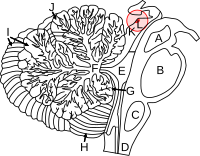
Photo from wikipedia
The output of the retina is organized into many detector grids, called ‘mosaics’ that signal different features of visual scenes to the brain1–4. Each mosaic comprises a single retinal ganglion… Click to show full abstract
The output of the retina is organized into many detector grids, called ‘mosaics’ that signal different features of visual scenes to the brain1–4. Each mosaic comprises a single retinal ganglion cell (RGC) type, whose receptive fields (RFs) tile space. Many mosaics arise as pairs, signaling increments (ON) and decrements (OFF), respectively, of a particular visual feature5. Using a model of efficient coding6, we determine how such mosaic pairs should be arranged to optimize the encoding of natural scenes. We find that information is maximized when these mosaic pairs are anti-aligned, meaning the RF centers between mosaics are more distant than expected by chance. We test this prediction across multiple RF mosaics acquired with large-scale measurements of RGC light responses from rat and primate. We find that ON and OFF RGC pairs with similar feature selectivity exhibit anti-aligned RF mosaics, consistent with theory. ON and OFF types that encode distinct features exhibit independent mosaics. These results extend efficient coding theory (ECT) beyond individual cells to predict how populations of diverse RGC types are spatially arranged.
Journal Title: Nature
Year Published: 2021
Link to full text (if available)
Share on Social Media: Sign Up to like & get
recommendations!